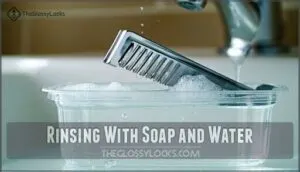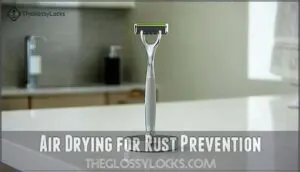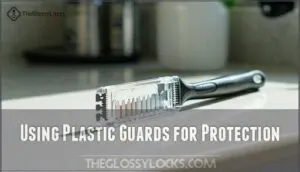This site is supported by our readers. We may earn a commission, at no cost to you, if you purchase through links.

Use a soft-bristle toothbrush to gently scrub stubborn buildup from blade edges. Soak your razor in rubbing alcohol for 30 seconds to disinfect and kill bacteria.
For deeper cleaning, submerge the blade in white vinegar to dissolve mineral deposits and soap residue. Always air-dry completely before storing to prevent rust formation.
These simple techniques keep your blades sharper longer and reduce skin irritation. The secret lies in understanding which cleaning agent works best for different types of buildup to maintain sharp blades.
Table Of Contents
- Key Takeaways
- Cleaning Razor Blades
- Razor Disinfection Methods
- Drying and Storing Razors
- Maintaining Razor Hygiene
- Razor Care and Shaving Routine
- Frequently Asked Questions (FAQs)
- How to properly clean razor blades?
- Is it okay to clean razors with alcohol?
- Will hydrogen peroxide clean my razor?
- How to clean gunk out of razor?
- Can I clean razor blades with dish soap?
- How often should I replace cartridge razors?
- What causes razor blades to rust quickly?
- Can I sharpen dull razor blades myself?
- Should I oil my razor for storage?
- Conclusion
Key Takeaways
- You’ll extend blade life significantly by rinsing with hot water after each shave and using a soft toothbrush to scrub away stubborn debris that dulls cutting edges.
- You should disinfect weekly with 70% rubbing alcohol or hydrogen peroxide to kill bacteria and prevent skin infections from contaminated blades.
- You must air-dry completely before storing your razor in a dry environment to prevent rust formation that destroys blade integrity and performance.
- You can maintain optimal sharpness by replacing blades every 1-2 weeks for daily shavers or when you notice tugging, irritation, or decreased cutting performance.
Cleaning Razor Blades
Cleaning razor blades properly prevents bacterial buildup and extends blade life substantially. You’ll achieve ideal results by combining water rinsing, brush scrubbing, and alcohol disinfection methods.
Removing Debris With Water
Running hot water over your razor blade creates the foundation for effective debris removal.
Hot water transforms stubborn debris into easily removable buildup for effortless razor maintenance.
Position the razor head under a powerful stream, rotating it to guarantee water pressure hits from multiple angles.
Hot water softens dried shaving cream and loosens trapped hair more efficiently than cold water.
This simple razor rinse technique removes most buildup without additional tools, making stream cleaning your first line of defense for razor blade maintenance and best razor hygiene.
Regular maintenance also involves checking for razor blade damage to guarantee longevity and hygiene.
Using Razor Brushes for Deep Cleaning
When basic rinsing won’t cut it, you’ll need a razor brush for deep cleaning stubborn buildup.
These specialized cleaning tools feature stiff bristles that reach into tight blade spaces where debris loves to hide.
Gently glide the brush vertically across your razor’s blades using smooth strokes—this technique removes grime that water alone can’t handle.
You’ll find razor brushes at most pharmacies, which is a convenient location to obtain a tool for removing stubborn buildup.
Soaking in Rubbing Alcohol for Disinfection
After deep cleaning with brushes, you’ll want to disinfect your razor blades for complete sanitation.
Submerge the razor head in 70% isopropyl alcohol for 5-10 minutes to kill bacteria and sterilize effectively.
This alcohol soak method eliminates harmful microorganisms while evaporating quickly to prevent rust.
Swish vigorously for thorough blade disinfection, then air-dry without rinsing.
Regular maintenance involves understanding proper alcohol cleaning techniques to extend the life of your razor blades.
Razor Disinfection Methods
Proper disinfection kills bacteria and prevents infections that can occur from contaminated razor blades. These three methods guarantee your razor stays sterile and safe for every shave.
Soaking in Isopropyl Alcohol
After removing debris, submerge your razor head completely in 70% isopropyl alcohol for thorough disinfection.
This alcohol soak method provides superior blade sterilization compared to water alone. The antimicrobial properties kill harmful bacteria within minutes.
Swish the razor gently, then let it soak for 5-10 minutes for deep razor sanitation.
These disinfect methods require no rinsing afterward—simply shake off excess alcohol and air-dry your blade.
For effective razor maintenance, understanding isopropyl alcohol disinfectant properties is vital for exceptional results.
Using Hydrogen Peroxide for Sterilization
Hydrogen peroxide offers effective blade sanitizing with its natural antimicrobial properties.
Hydrogen peroxide naturally sterilizes blades while breaking down into harmless water and oxygen.
This sterilization method requires a 3% solution diluted with water for chemical safety.
Soak your razor components for 10-15 minutes to achieve thorough sterilization.
The hydrogen benefits include breaking down into harmless water and oxygen, making it environmentally friendly.
Always rinse thoroughly after treatment to prevent material damage from prolonged exposure.
Regular maintenance involves checking for rust prevention methods to guarantee the longevity of the razor and ensure proper maintenance.
Rinsing With Soap and Water
Most soap and water combinations provide excellent blade soaking for gentle cleaning during daily maintenance.
You’ll find lukewarm water temperature works best for razor blade cleaning. Apply liquid soap directly onto blades, then rinse thoroughly.
This cleaning razor blades method removes debris effectively. Regular blade cleaning methods like this maintain razor blade maintenance standards without harsh chemicals, using gentle cleaning and lukewarm water.
Drying and Storing Razors
Properly drying your razor after cleaning prevents rust formation and maintains blade sharpness for longer use.
Smart storage in dry environments with protective guards keeps your razor performing at its best between shaves.
Air Drying for Rust Prevention
Air drying prevents rust by removing moisture that causes blade corrosion.
After disinfection, shake off excess water and place your razor in a well-ventilated area.
Proper airflow around all surfaces doubles blade longevity compared to damp storage.
Use a razor stand to elevate blades above surfaces for maximum air circulation and rust prevention.
This method is often used in conjunction with an air dry razor system for ideal results, enhancing blade longevity and ensuring proper airflow.
Storing in Dry Environments
Once you’ve allowed your razor to air dry completely, you’ll need to choose the right storage location.
Avoid humid areas like bathroom counters or shower alcoves where moisture lingers. Instead, select a dry, well-ventilated spot with good air circulation.
Proper razor blade storage in a controlled dry environment prevents rust formation and extends blade life. Smart humidity control protects your investment while maintaining peak blade performance.
Using Plastic Guards for Protection
Plastic guards serve as your razor’s armor against damage and dulling.
These protective sleeves, blade covers, and razor caps shield cutting edges from nicks and moisture.
Quality guard materials like durable plastic coatings extend blade life substantially.
You’ll find razor caps prevent accidental cuts while maintaining razor safety during storage and travel.
Proper handling techniques, including safe razor blade safety precautions, are vital for preventing accidents and ensuring overall razor maintenance and care involves razor safety measures.
Maintaining Razor Hygiene
You’ll extend your razor’s lifespan substantially by establishing a consistent hygiene routine that goes beyond basic rinsing.
Regular inspection and timely blade replacement prevent the dullness and bacterial buildup that cause irritation and poor shaving performance, which can be mitigated by a consistent hygiene routine.
Regular Rinsing for Sharpness
When you rinse your razor blade after each stroke during shaving, you’re performing essential razor maintenance that directly impacts sharpness tips.
Use warm water temperature for ideal results, as it effectively removes hair and debris buildup.
This simple blade inspection and cleaning frequency practice prevents dulling, ensuring your razor blade cleaning routine maintains peak razor hygiene and extends blade life substantially.
Inspecting Blades for Damage
Before you replace worn blades, you’ll want to examine them closely for signs of trouble.
Check your razor blade for nicks, chips, or bent edges during your blade inspection routine.
Look for rust spots that signal corrosion and test sharpness by gently running your finger along the blade’s side.
This damage check prevents skin irritation and maintains proper razor hygiene through regular edge examination.
Replacing Blades for Optimal Performance
You’ll know it’s time for razor blade replacement when you feel dullness discomfort during shaving.
Daily shavers need fresh blades every 1-2 weeks, while occasional users can extend blade lifespan to 2-3 weeks.
Watch for tugging sensations and increased irritation reduction needs.
Rust prevention becomes harder with worn blades, so monitor shave frequency closely.
Replace immediately when blade performance drops to maintain superior razor blade lifespan.
Understanding the replacement frequency guidelines is vital for achieving the best shaving results.
Razor Care and Shaving Routine
Your razor’s performance depends on proper care throughout your shaving routine. Consistent pre-shave preparation and post-shave maintenance guarantee clean cuts and extend blade life substantially.
Pre-Shave Rinsing for Lubrication
Before diving into your shave, warm water prep transforms your razor blade cleaning routine into shave readiness perfection.
This pre shave routine activates blade lubrication while removing residual debris that could compromise your skin’s comfort.
- Warm Water Prep: Run hot water over blades for 10-15 seconds to soften dried shaving cream
- Blade Activation: Gentle flicking motions dislodge trapped hair and activate razor lubrication systems
- Debris Inspection: Check for rust spots or buildup that requires additional razor maintenance attention
- Shave Readiness: Clean blades guarantee smooth gliding and prevent tugging during your shaving experience
Post-Shave Cleaning for Longevity
After thorough rinsing, your razor blade cleaning doesn’t end there. Post-shave maintenance determines how long your blades stay sharp and hygienic.
Proper cleaning solutions and razor sanitizing techniques preserve blade quality substantially. Regular maintenance involves understanding the importance of a good electric razor cleaning routine to extend blade life.
| Cleaning Method | Time Required | Blade Preservation |
|---|---|---|
| Warm water rinse | 30 seconds | Basic debris removal |
| Alcohol disinfection | 2-3 minutes | Extended blade life |
| Complete air drying | 10-15 minutes | Maximum rust prevention |
Consistent shave routine maintenance keeps your razor blade hygiene at its best while extending replacement intervals.
Regular Maintenance for Smooth Shaving
Maintaining proper razor blade cleaning methods through consistent blade inspection guarantees superior performance.
You’ll want to examine your razor before each shave preparation, checking for rust, dullness, or debris buildup.
Regular razor sanitizing between uses prevents bacterial growth while protecting your skin.
Weekly deep cleaning with razor maintenance solutions keeps blades sharp longer.
This routine approach to shaving razor maintenance delivers consistently smooth results.
Frequently Asked Questions (FAQs)
How to properly clean razor blades?
Clean razor blades effectively by rinsing with hot water after each use, then disinfect weekly in rubbing alcohol. Store completely dry to prevent rust and maintain sharpness.
Is it okay to clean razors with alcohol?
Yes, you can safely clean razors with alcohol.
Isopropyl alcohol (70%) effectively kills bacteria and sterilizes blades without causing rust.
Simply soak the razor head for 5-10 minutes, then air-dry—no rinsing needed.
Will hydrogen peroxide clean my razor?
Hydrogen peroxide effectively cleans your razor by dissolving organic buildup and killing bacteria.
It’s gentler than alcohol but still disinfects thoroughly.
Soak your blade for several minutes, then rinse with warm water and dry completely.
How to clean gunk out of razor?
**Gunk stuck like cement?
Rinse your razor under hot water, tapping gently to dislodge debris.
For stubborn buildup, use a clean toothbrush with vertical strokes, then soak in rubbing alcohol for disinfection.
Can I clean razor blades with dish soap?
Dish soap works perfectly for cleaning razor blades. Apply a small amount, gently scrub with a soft toothbrush, then rinse thoroughly with warm water to remove all soap residue.
How often should I replace cartridge razors?
Studies show cartridge razors lose 50% effectiveness after just 5-7 shaves.
You’ll get best performance by replacing them every 1-2 weeks or after 6-10 uses, depending on your hair coarseness and shaving frequency.
What causes razor blades to rust quickly?
Moisture and humidity are your blade’s worst enemies.
When you don’t dry your razor properly after use or store it in humid places like shower alcoves, water accelerates rust formation and dulls cutting edges quickly.
Can I sharpen dull razor blades myself?
You can sharpen razor blades using denim, leather strops, or specialized sharpening devices, but results vary.
Most blades aren’t designed for resharpening, so replacement often provides better performance than DIY sharpening attempts.
Should I oil my razor for storage?
You don’t need to oil your razor for storage.
Proper drying and storing in a dry environment prevents rust effectively.
Oil can trap debris and isn’t necessary for modern razor maintenance.
Conclusion
Like a well-tuned engine, your razor blade cleaning methods directly impact your shaving performance and skin health.
Consistent cleaning removes bacteria and debris that cause irritation and infections. You’ll extend blade life by removing mineral deposits and soap buildup that dull cutting edges.
Regular disinfection with alcohol or hydrogen peroxide eliminates harmful microorganisms.
Proper drying prevents rust formation that destroys blade integrity.
These proven razor blade cleaning methods guarantee superior hygiene and exceptional shaving results every time.
- https://www.wilkinsonsword.com/blogs/mens/how-to-clean-a-razor-head-and-razor-blades
- https://cremocompany.com/blogs/blog/how-to-clean-your-safety-razor
- https://www.phonesoap.com/blogs/news/how-to-sanitize-razor
- https://www.omegasonics.com/knowledge-center/blog/prolonging-the-lifespan-of-razor-blades-with-an-ultrasonic-cleaner/
- https://www.badgerandblade.com/forum/threads/how-do-i-sterilize-a-razor.241718/











